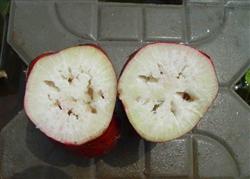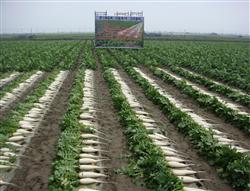Cultivation techniques of Mini Carrot
1. Variety sources finger-shaped carrots and spherical carrots are new varieties of carrots introduced from Nagoya, Japan in 2003 by the vegetable Institute of Inner Mongolia Academy of Agriculture and Animal Husbandry Sciences. Trial planting are all pocket mini carrots, which can be used as specialties, raw food and dish platter decoration. Second, characteristics 1. Finger-shaped carrots small carrot varieties, shaped like adult fingers, so it is called finger-shaped carrots. The leaf cluster is erect, the leaf color is dark green, the leaf is small, the fleshy root is 10 ~ 12 cm long, the root is 1.5 ~ 2 cm thick, the root is cylindrical, the outer skin is orange, and the inner and outer color is the same. The fleshy root expands quickly, it is not easy to be exposed on the ground, and the growing period is 70 min. It has delicate meat, crisp and sweet taste, very fine core, much moisture, beautiful root shape and good ending. It is suitable for fresh food and western food. It is a precocious mini carrot, which can be used for cultivation in spring and autumn. 2. Spherical carrot small carrot variety, shaped like cherry water carrot, so it is called spherical carrot. The leaf cluster is erect, the leaf color is dark green, the leaf is small, the fleshy root is 3mur4cm thick, the root is spherical, and the epidermis, flesh and core are all orange. The fleshy root expands quickly, the ground is not easy to be exposed, the end is good, the growth period is about 70 days, the meat is delicate, sweet and delicious, good quality, suitable for fresh food, western food. It is a precocious mini carrot. 3. Main cultivation techniques 1. Prepare the soil and fertilize. Choose deep, fertile and well-drained loam or sandy loam with a depth of 15 cm. Base fertilizer, especially phosphate fertilizer, should be re-applied in fertilization, and 3000 kg / mu of rotten organic fertilizer should be applied in combination with ploughing and ploughing after the previous harvest. After soil preparation and fertilization, sufficient bottom water should be irrigated 7 days before sowing to ensure soil moisture during seedling emergence. In order to prevent grass damage during seedling emergence, after leveling the border, 120 ml of trifluralin was used for 30 kg of water per mu, spray treatment of topsoil was used alternately, and each agent was limited to one time during the growth period. 2. Scientific management. Watering the soil moisture before seedling emergence after sowing to keep the soil moist. Field observation should be carried out at any time to ensure the whole seedling. After the seedlings came out, the seedlings were thinned with 2 true leaves, 3 with 3 true leaves and 6 with 6 true leaves. The row spacing of finger carrots and spherical carrots were 5cm × 18cm and 5cm × 20cm respectively. The seedlings were ploughed after middle tillage to achieve the effect of weeding and provide oxygen to the soil. After the seedling was fixed, it began to be watered and topdressing to promote the expansion of the rhizome. During the whole growth period, topdressing and watering could be done for 2 times. Always keep the soil moist to prevent the fleshy roots from being thin, rough or cracked. 3. Control diseases and insect pests. The seedling stage is mainly caused by underground pests, such as ground tiger, mole cricket and so on.
- Prev

How to prevent hollowness of radish
The heart of radish bran has a lot to do with poor soil drainage, uneven application of base fertilizer and topdressing, or late topdressing and premature cessation of leaf growth. Through intensive cultivation, according to the characteristics of radish fertilizer demand, uniform fertilization and balanced supply of water to promote the normal growth of radish plants. The fleshy root is formed under steady and proper conditions, and the bran heart appears.
- Next

Control methods of main diseases of radish
Radish is an annual or biennial herb of the genus Cruciferae, and it is one of the main root vegetables. Radish has a large absorption of nitrogen, phosphorus and potassium, so it is a high-yield crop with high fertilizer demand. For each production of 4000kg radish, it is necessary to absorb nitrogen 8.5kg, phosphorus pentoxide 3.3 kg, potassium oxide 11.3.
Related
- Where is it suitable to grow horseradish in China? it is expected to see the middle altitude horseradish in Alishan.
- How to prevent tomato virus disease reasonably? (Control methods included)
- Many people like to plant towel gourd on the balcony. What are the main points of this method and management?
- What crops can chili peppers be mixed with?
- Fertilization techniques and matters needing attention in Tomato
- What are the grafting techniques for peach seedlings in spring?
- Harm and control methods of root swelling disease of Chinese cabbage
- What are the pests of sweet potatoes? How to prevent and cure it?
- Symptoms, causes and Control methods of navel Rot in Tomato
- The cause of "Cucumber rotten bibcock" in Farmers' planting Cucumber and its Control Plan

